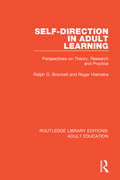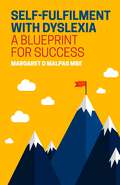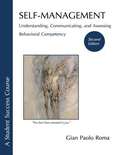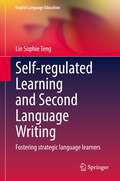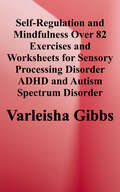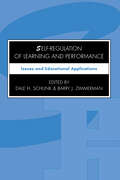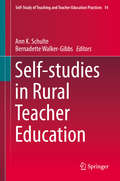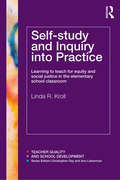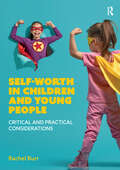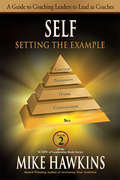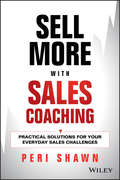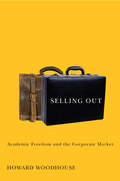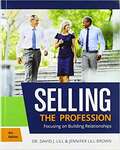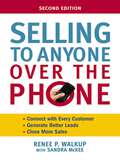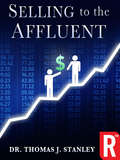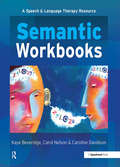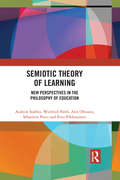- Table View
- List View
Self-directed Learning Oriented Assessments in the Asia-Pacific
by Magdalena Mo MokThe Asia-Pacific region needs to maximize the benefits of education to enable it to compete in an economic future dominated by innovation, in which assessing student progress must be an empowering rather than delimiting factor. This detailed exposition of the theoretical basis and application tools of self-directed learning-oriented assessment (SLOA) reflects the very latest research championed by the Assessment Research Centre at The Hong Kong Institute of Education. Featuring a range of relevant case studies, it explores the varied theoretical issues related to SLOA and offers an integrated view of the system fully in line with the constructivist paradigm of learning which advocates formative rather than summative assessment. Many of the initiatives outlined here are firsts in the region. SLOA is already being applied in many schools with links to the ARC. It is an approach to assessment that acknowledges the centrality of self-directed learning and which positions assessment as a tool to enable and enhance self-directed learning. It draws on several theories of learning and assessment, including the constructivist notion that learning is best achieved when students take ownership of their educational process, setting their own goals and monitoring their own progress towards those goals. SLOA has been the research and service approach of the ARC since 2005. In the intervening years the centre has developed a number of tools to facilitate SLOA learning and assessment, including vertical ability scales, teacher-friendly computer software and packages for self-directed learning.
Self-directed Learning: Critical Practice
by Rob Collins Merryl HammondAimed at those educators who wish to make their practice more consistent with progressive educational principles, namely helping learners to take greater control over planning and managing their own learning. The book contains a balance of theory and practical suggestions.
Self-direction in Adult Learning: Perspectives on Theory, Research and Practice (Routledge Library Editions: Adult Education)
by Ralph G. Brockett Roger HiemstraOriginally published in 1991, this book provides the reader with a comprehensive synthesis of developments, issues and practices related to a self-direction in learning. it presents strategies for facilitating self-directed learning as an instructional method and for enhancing learner self-direction as an aspect of adult personality. The idea of self-directed learning is not a new one but has received renewed attention in education circles and has particular significance for the adult education sector.
Self-esteem: A Guide for Teachers
by David Miller Teresa MoranDo some of your pupils suffer from low or fragile self-esteem? Perhaps you want to help, but don′t know how? If so, this book is for you. Using insights from theory, research and classroom practice, it provides strategies and techniques that will enhance the confidence of primary school children through authentic learning experiences. This book includes: -discussions on a range of issues surrounding self-esteem enhancement in school -studies of recent work in this area -links between self-esteem and the development of competence (fitting in with the Raising Attainment agenda) -research evidence from real primary classrooms -a clear articulation of strategies and techniques to use in classrooms -a summary and analysis of the key theoretical and empirical work in the area The book′s clear practical focus will be of interest to all teachers and managers keen to enhance self-esteem in their schools. It will prove equally useful for teachers in training and more experienced teachers undertaking further study. This book will empower you to develop your practice with a clear sense of direction - and with increased confidence. David Miller is Professor of Education at the University of Dundee. Teresa Moran is the Associate Dean (Education and Professional Development) at the University of Dundee.
Self-fulfilment with Dyslexia: A Blueprint for Success
by Margaret MalpasDyslexia won't stop you from writing your own success story. Discover the ten key traits which people with dyslexia have harnessed in order to reach success and self-fulfilment. Dyslexia brings both challenges and the potential gift of a unique skill set - through a combination of academic research and case studies, this book shows how you can use all of this to your advantage. From increasing your self-esteem to imaginative problem solving, each of the ten secrets to success is explained and brought to life through interviews with accomplished people describing how they have profited from a single star characteristic in realizing their goals. Approach the obstacles of dyslexia pro-actively, and unlock your potential with this inspiring step by step guide. Royalties from the sale of this book will be donated to the British Dyslexia Association.
Self-management: Understanding, Communicating, And Assessing, Behavioral Competency (Second Edition)
by Gian RomaEach year millions of academically capable students drop out of college for non-financial reasons. It is a troubling problem that highlights the need for students to be more resilient, prepared, and effective at reaching their goals. How can students position themselves to succeed in this increasingly demanding, changing, and competitive world? One way is to understand and practice the basic behaviors necessary to achieve goals. The second edition of "Self-Management: Understanding, Communicating, and Assessing, Behavioral Competency" offers an innovative approach to student success, which focuses on improving student behavior. Behaviors communicate a great deal. Because certain behaviors lead to better academic performance than others, it is essential that students learn about the relationship between behavior and academic performance. The main purpose of this book is to help students achieve their goals by clarifying the behaviors that they alone are responsible for, and showing how these behaviors lead to success. This book introduces a comprehensive self-management model to help students understand and assess their own behavioral decision-making. With this model, the author shows how behavior can affect not only academic success, but also life after graduation. The book provides a practical framework, "how to" exercises, a new behavioral observation measurement system, self-tests, and a proven behavioral change methodology for individuals, families, and schools seeking to establish, assess, and improve behavioral performance. College faculty and advisors that teach student development, management, and student success courses should not be without this invaluable training resource. Instructor's resources include PowerPoint presentations, and test banks for every unit. Professor Roma can be reached at romag@sunybroome. edu. He gets many emails, and will try to respond to yours as quickly as he can. He usually doesn't answer calls from unrecognized phone numbers, so please leave a message if he doesn't answer, and he will call you back as soon as he is able. Office: (607) 778-5143Cell: (607) 760-6633
Self-regulated Learning and Second Language Writing: Fostering strategic language learners (English Language Education #26)
by Lin Sophie TengThis monograph is to investigate practical applications and contributions of self-regulated learning (SRL) to second/foreign language (L2) writing from sociocognitive and sociocultural perspectives. It showcases a comprehensive and updated review of conceptual and methodological issues of SRL and the state-of-the-art research on its applications to L2 learning and teaching. This volume further elaborates the design and results of a large-scale project which conducts observational and intervention studies investigating SRL strategies in L2 writing. This book reveals that a cross-disciplinary understanding of SRL strategies plays a crucial role in advancing theoretical functions of SRL and in extending its applications to L2 education in general, and L2 writing in particular. This book makes significant contributions to developing and validating new conceptual frameworks and tools for evaluating multidimensional structures of SRL strategies and self-efficacy in L2 writing; elucidating the interplay of personal, behavioral, environmental and psychological factors with SRL strategies and writing performance; and presenting an effective self-regulation instructional model for nurturing L2 learners’ motivation and confidence to strategize, reflect and succeed in writing.Teng has established herself as one of the prominent scholars in the discussion of self-regulated learning strategies. Her contribution to the fields of L2 writing and strategic learning are undeniable. This monograph is an excellent showing of how her endeavors to bring established theories from educational psychology to applied writing research have progressed over a number of methodologically rigorous studies. It should be required reading for anyone with an interest in cultivating strategic writers not only in the Chinese context but worldwide. Nathan Thomas, UCL Institute of Education
Self-regulation and Mindfulness: Over 82 Exercises and Worksheets for Sensory Processing Disorder, ADHD, and Autism Spectrum Disorder
by Varleisha GibbsThe author has created a unique, evidence-based resource for helping children who have trouble self-regulating, staying focused, managing their senses and controlling their emotions. <p><p>Based on the latest research in neuroscience, Self-Regulation and Mindfulness provides highly practical, kid friendly lessons to teach therapists, parents, educators and children about their brain and body, so they can build the needed skills to self-regulate. <p>- Hands-on activities <p>- Step-by-step exercises <p>- Coloring pages and worksheets <p><p>Clear, concise and fun activities to address your children's arousal, attention, and social participation: <p>- Touch and Heavy Work <p>- Hydration and Oral Motor Activities <p>- Metronome, Timing and Sequencing Exercises <p>- Right and Left Brain Integration Methods <p>- Patterns and Repetition Recognition <p>- Vision and Sound Skills <p>- Movement Coordination <p>- Inhibition Techniques
Self-regulation of Learning and Performance: Issues and Educational Applications
by Barry J. Zimmerman Dale H. SchunkIn recent years, educators have become increasingly concerned with students' attempts to manage their own learning and achievement efforts through activities that influence the instigation, direction and persistence of those efforts. In 1989, Zimmerman and Schunk edited the first book devoted to this topic. They assembled key theorists offering a range of perspectives on how students self-regulate their academic functioning. One purpose of that volume was to provide theoretical direction to ongoing as well as nascent efforts to explore academic self-regulatory processes. Since that date, there has been an exponential surge in research. This second volume on academic self-regulation offers the fruits of the first generation of research. It also addresses a number of key issues that have arisen since then such as how self-regulation differs from such related constructs as motivation and metacognition, and whether students can be taught self-regulatory skills. The contributors reveal an interesting, uplifting, and at times, disturbing picture of how students grapple with the day-to-day problems of achieving in circumstances with inherent limitations and obstacles. This volume provides insight into the source of students' capabilities to surmount adversities -- the origins of their self-initiated processes designed to improve learning, motivation, and achievement. The text is organized on the basis of a conceptual framework that analyzes academic self-regulation into four major dimensions. That model is presented in the first chapter, and key processes that influence each of these dimensions are discussed by prominent researchers in the chapters that follow. Because each chapter is written to follow a common format, this work provides a level of continuity and parsimony normally found only in authored textbooks.
Self-studies in Rural Teacher Education
by Ann K. Schulte Bernadette Walker-GibbsThe purpose of this book is to highlight the work of teacher educators in the field of rural education. In this book, education faculty who work in teacher education study the ways in which one's identity impacts one's teaching and the partnerships with rural schools. Although the field of research on teacher preparation has an abundance of studies on preparing students for the challenges of urban settings, there is much less emphasis on rural education, despite the prevalence of rural schools. This book problematises notions of rural or rurality which is often considered via a deficit or a generalised model where a stereotype of one kind of rural is outlined. Developing more multi-faceted understandings of rurality is a key to attracting and retaining teachers who understand the complexities and opportunities of living and working in rural spaces.
Self-study and Inquiry into Practice: Learning to teach for equity and social justice in the elementary school classroom (Teacher Quality And School Development Ser.)
by Linda R. KrollThere are new pressures and familiar pressures on teacher educators to prepare teachers who will be able to teach successfully in a changing world, and who will be able to change the world. The question of how to prepare well-qualified teachers has become an international question with global responses and consequences. This book describes a stance
Self-worth in children and young people: Critical and practical considerations
by Rachel BurrChallenges current adult-led approaches to working with vulnerable young people, and introduces practitioners and students to creative methods that will enhance the self-worth of children and teenagers.Anthropologist and social worker, Rachel Burr, outlines clear communication techniques for working with children and young people to support them towards self-determination. By critically examining the dominant approaches to children and young people’s mental health, she provides straightforward practical strategies that can be used to address emotional upset, loss, and aid recovery.There has never been a more pressing time to encourage young people and children to engage in methods that allow them to develop a new sense of self-worth and purpose. Whether you’re a professional already working with children, or a student studying for a child-related qualification, this strength-based approach will help you to help children and young people develop a stronger sense of self which can be taken forward and used independently.
Self: Setting the Example (SCOPE of Leadership Book Series #2)
by Mike HawkinsHow to cultivate character and mental fitness to run the show. Second in the “most comprehensive treatment of leadership I’ve ever seen by one author” (Jim Kouzes, coauthor of The Leadership Challenge).Self: Setting the Example sets the foundation for the ability to lead others by developing the competencies of great self-leadership. Effective leaders possess intrinsic passion, character, courage, and confidence that others respect and want to follow. When you lead yourself well, operate productively, and think strategically, others notice and are motivated to attain the higher standards you demonstrate.The SCOPE of Leadership book series teaches the principles of a coaching approach to leadership and how to achieve exceptional results by working through people. You will learn a straightforward framework to guide you in developing, enabling, exhorting, inspiring, managing, and assimilating people. Benefit from the wisdom of many years of leadership, consulting, and executive coaching experience. Discover how to develop the competencies that align consistently with great leadership.
Sell More With Sales Coaching
by Peri ShawnSales coaching tools and strategies to help you sell moreSales executives and business leaders are looking for ways to increase their revenues without major changes to their technology, processes or workforce management. When done effectively, sales coaching can be the catalyst that improves sales results, team morale and employee retention. Sell More with Sales Coaching provides results-proven sales coaching material that includes assessment, exercises and sales coaching questions.As a result of applying the tools and strategies in this book, sales leaders and teams will drive higher revenues and performance by:Assessing team members' sales capacitiesDetermining what type of coaching is needed on an individual basisIdentifying sales mistakes being committed by salespeopleCoaching salespeople to avoid committing sales mistakesImproving the quality of sales conversationsIncreasing the quality of conversations within the teamLeveraging the use of CRM during sales coachingThe author's company, the Coaching and Sales Institute, has worked with large sales forces and provided training for the launch of the debit card, and one of the fastest-growing divisions of the Royal Bank of Canada.
Selling Hope and College: Merit, Markets, and Recruitment in an Unranked School
by Alex PosecznickIt has long been assumed that college admission should be a simple matter of sorting students according to merit, with the best heading off to the Ivy League and highly ranked liberal arts colleges and the rest falling naturally into their rightful places. Admission to selective institutions, where extremely fine distinctions are made, is characterized by heated public debates about whether standardized exams, high school transcripts, essays, recommendation letters, or interviews best indicate which prospective students are "worthy."And then there is college for everyone else. But what goes into less-selective college admissions in an era when everyone feels compelled to go, regardless of preparation or life goals? "Ravenwood College," where Alex Posecznick spent a year doing ethnographic research, was a small, private, nonprofit institution dedicated to social justice and serving traditionally underprepared students from underrepresented minority groups. To survive in the higher education marketplace, the college had to operate like a business and negotiate complex categories of merit while painting a hopeful picture of the future for its applicants. Selling Hope and College is a snapshot of a particular type of institution as it goes about the business of producing itself and justifying its place in the market. Admissions staff members were burdened by low enrollments and worked tirelessly to fill empty seats, even as they held on to the institution’s special spirit. Posecznick documents what it takes to keep a "mediocre" institution open and running, and the struggles, tensions, and battles that members of the community tangle with daily as they carefully walk the line between empowering marginalized students and exploiting them.
Selling Out
by Howard WoodhouseSelling Out demonstrates that the logics of value of the market and of universities are not only different but opposed to one another. By introducing the reader to a variety of cases, some well known and others not, Woodhouse explains how academic freedom and university autonomy are being subordinated to corporate demands and how faculty have attempted to resist this subjugation. He argues that the mechanistic discourse of corporate culture has replaced the language of education - subject-based disciplines and the professors who teach them have become "resource units," students have become "educational consumers," and curricula have become "program packages." Graduates are now "products" and "competing in the global economy" has replaced the search for truth.
Selling Out: Academic Freedom and the Corporate Market
by Howard WoodhouseSelling Out demonstrates that the logics of value of the market and of universities are not only different but opposed to one another. By introducing the reader to a variety of cases, some well known and others not, Woodhouse explains how academic freedom and university autonomy are being subordinated to corporate demands and how faculty have attempted to resist this subjugation. He argues that the mechanistic discourse of corporate culture has replaced the language of education - subject-based disciplines and the professors who teach them have become "resource units," students have become "educational consumers," and curricula have become "program packages." Graduates are now "products" and "competing in the global economy" has replaced the search for truth.
Selling Us the Fortress: The Promotion of Techno-Security Equipment for Schools
by Ronnie CasellaIn the wake of school shootings and the more recent threats of terrorism, schools - like many public institutions - have begun installing techno-security equipment ranging from surveillance cameras to microchip tracking systems. Is this equipment necessary and who really benefits from its use? Selling Us the Fortress, the first qualitative study of the relationship between the security industry and schools, analyzes how technologies once reserved primarily for war have become a common fixture in modern schools, including detailing how school personnel are "sold" on the idea that the mass installation of techno-security is in their best interest.
Selling the Profession: Focus on Building Relationships
by David Lill Jennifer Lill BrownSelling: The Profession is the roadmap to a rewarding sales career! Today, more than ever, it is all about relationship building in a digital world. In the 8th edition of this field-tested guide to selling, you will learn to: <p><p> • Appreciate that you are selling every day, regardless of your career. <p> • Use social media to connect with potential customers. <p> • Make good first impressions and build rapport. <p> • Recognize social styles and nonverbal signals. <p> • Effectively manage your time. <p> • Uncover needs by asking questions and listening. <p><p> The authors have taken a refreshingly practical and modern approach to professional selling. The 8th edition is divided into two parts: <p><p> • Part 1 explores "Selling Success Fundamentals" by examining the foundational strategy pieces needed for building a long-lasting career. This includes how to manage your time, read nonverbal cues, communicate with others within and outside your company, and recognize what drives people to buy. <p><p> • Part 2 is all about the "Relationship Selling Cycle." The eight-step process will walk you through every interaction with potential customers--from prospecting and pre-approach to the close and extend to the actions needed after the close.
Selling to Anyone Over the Phone: Connect With Every Customer; Generate Better Leads; Close More Sales
by Renee Walkup Sandra McKeeThis easy-to-follow guide for salespeople trying to generate product excitement over the phone provides quick strategies to help you boost your success rate.As more and more organizations scale back on their in-the-field sales operations, sales pros have had to focus their energy and skills on closing deals over the phone--and doing it faster than ever before. Authors Renee P. Walkup and Sandra McKee have included new chapters on using advanced technology (e.g., webinars and teleconferencing) and selling to customers from other cultures and countries.Selling to Anyone Over the Phone teaches you how to:ensure callbacks,build trust,partner with decision makers,and use personality-matching techniques to build connections with and relate to people they can&’t see face-to-face.Complete with an invaluable appendix on handling customer complaints and new sample call dialogs, Selling to Anyone Over the Phone simplifies an increasingly important facet of the sales role so you can get back to doing what you do best--providing excellent products and services to your customers and exceeding your sales goals.
Selling to the Affluent: The Professional's Guide To Closing The Sales That Count
by Dr. Thomas J. StanleyFrom the New York Times–bestselling coauthor of The Millionaire Next Door: &“No one better illuminates the who, where, and how of the affluent market&” (J. Arthur Urciuoli, former chairman at Merrill Lynch). In the bestselling classic The Millionaire Next Door, Dr. Thomas J. Stanley showed his readers where to look for the wealthy. In Selling to the Affluent, he shows us how to persuade them. This book provides an insightful roadmap of the motivations and purchasing patterns of the affluent—and delivers a strategy for salespeople to leverage that information to the best advantage. This book outlines all phases of the sales process, from approaching wealthy prospects to pinpointing their wants and needs—frequently different from those of less affluent markets—and selling both tangible and intangible products. It profiles several key demographics within the wealthy subset—including business owners, men and women, and the retired. It&’s the most detailed and inclusive manual on the market for selling to the wealthy. &“Dr. Stanley&’s strategies consider the real needs of the high income professionals—needs that go beyond any product or service. These needs are psychological and revolve around the recognition of the individual&’s extraordinary level of achievements. He provides some terrific insights as to how to solicit and maintain business by unconventional, but highly effective means.&” —Carolyn J. Cole, chairman and founder of The Cole Group and The institute of Economics and Finance &“Selling to the Affluent is well written, relevant, and exciting; it presents an important complementary extension to Marketing to the Affluent.&” —William D. Danko, PhD, coauthor of The Millionaire Next Door
Semantic Perception Theory: A New Theory on Children's Language Development (Perspectives on Rethinking and Reforming Education)
by Kekang HeBased on an in-depth study of children’s language development theory, this book puts forward the original proposition that semantic perception is the human sixth sense. Presenting a detailed, complete, and scientific argumentation, it asserts that the innateness of semantic perception has a physiological basis and that language acquisition is based on semantic perception, and proposes the idea of a critical period of nurture and language growth. To this end, the book not only contrasts children’s language acquisition processes and the process of adult speech generation and comprehension, but also discusses the ability to read and write, describing this important stage of children’s language development and analyzing semantic perception. Focusing on education and psychology, it also discusses the use of semantic perception theory to instruct teaching and learning. This book is a valuable resource for teachers, researchers, practitioners and graduate students in the fields of educational technology, child development and language learning, as well as anyone interested in children’s language development.
Semantic Workbooks
by Carol Nelson Kay Beveridge Caroline Davidson Stobhill HospitalUsing hundreds of clear and captivating illustrations, this resource, divided into 6 sections, housed in a ring binder provides a range of semantic therapy ideas and materials. Designed for use with adults with acquired neurological disorders and based on the cognitive neuropsychological model of language processing, each workbook covers specific aspects of semantics. "Contains an excellent range of visual materials. "Gives a range of semantic therapy ideas and materials that can be used individually or modified for use with groups. "Exercises are graded in order of difficulty and presented in a range of formats, eg, pictures only, written word only and pictures with words. "Designed for use with adults with acquired neurological disorders and based on the cognitive neuropsychological model of language processing. "Many of the picture exercises would also be suitable for semantic work with children. "Gives the busy therapist an easy, quick and high quality resource for everyday use. Carol Nelson and Caroline Davidson have worked at the Stobhill Hospital in Glasgow for several years. These workbooks were created as an easily usable resource for therapists who work with aphasic clients. After 13 years' experience in working with children and young adults with learning disabilities Kave Beveridge moved to the position of Speech and Language Therapy Assistant at Stobhill Hospital in 1993. She worked in the Speech and Language Therapy department until she retired in September 2008.
Semiotic Subjectivity in Education and Counseling: Learning with the Unconscious (Routledge International Studies in the Philosophy of Education)
by Inna R. SemetskySemiotic Subjectivity in Education and Counseling demonstrates the importance of addressing the concept of the unconscious in learning. Exploring the innovative concept of edusemiotics, it challenges the received notion of learning as solely academic and linguistic, instead offering an ethico-aesthetic paradigm that draws on transdisciplinary research in the context of this new direction in educational theory. The chapters explore the production of subjectivity within the process of semiosis as the action and transformation of signs. An unorthodox pedagogy of the unconscious blends with the therapeutic dimension and produces subjectivities that emerge in the midst of the relational dynamics of experience. The book argues for holistic education that rejects the schism between matter and spirit pervading Western thinking and represents a shift in rethinking spirituality while never separating it from logic and reason. Giving voice to the unconscious contributes to learning and changing our habits as an important objective in educative and counseling practices. The book critically examines the legacy of Charles S. Peirce, Lev S. Vygotsky and other forerunners of edusemiotics. It will be essential reading for academics, researchers and postgraduate students across the fields of educational philosophy, educational psychology and counseling as well as science studies.
Semiotic Theory of Learning: New Perspectives in the Philosophy of Education
by Alin Olteanu Andrew Stables Eetu Pikkarainen Winfried Nöth Sébastien PesceSemiotic Theory of Learning asks what learning is and what brings it about, challenging the hegemony of psychological and sociological constructions of learning in order to develop a burgeoning literature in semiotics as an educational foundation. Drawing on theoretical research and its application in empirical studies, the book attempts to avoid the problematization of the distinction between theory and practice in semiotics. It covers topics such as signs, significance and semiosis; the ontology of learning; the limits of learning; ecosemiotics; ecology and sexuality. The book is written by five of the key figures in the semiotics field, each committed to the belief that living is a process of interaction through acts of signification with a signifying environment. While the authors are agreed on the value of semiotic frameworks, the book aims not to present an entirely coherent line in every respect, but rather to reflect ongoing scholarship and debates in the area. In light of this, the book offers a range of possible interpretations of major semiotic theorists, unsettling assumptions while offering a fresh, and still developing, series of perspectives on learning from academics grounded in semiotics. Semiotic Theory of Learning is a timely and valuable text that will be of great interest to academics, researchers and postgraduates working in the fields of educational studies, semiotics, psychology, philosophy, applied linguistics and media studies.


